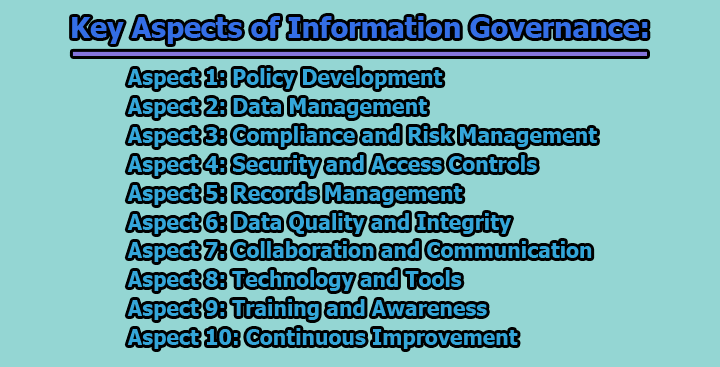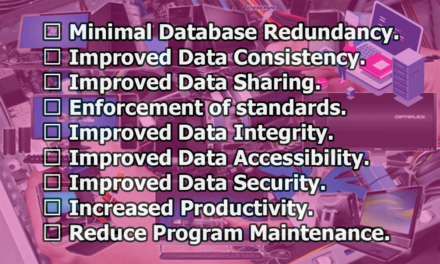Key Aspects of Information Governance:
Information governance is a crucial facet of organizational management, encompassing a strategic framework that ensures the proper handling, security, and compliance of information assets. This holistic approach involves the coordination of people, processes, and technology to optimize the value of information while mitigating associated risks. In this article, we will explore some of the key aspects of information governance.
Aspect 1: Policy Development:
Policy development in information governance is foundational to establishing a structured framework for the creation, use, storage, and disposal of information within an organization. It ensures that employees understand how to handle information assets appropriately and that these practices align with legal requirements, industry standards, and the organization’s strategic objectives.
1.1 Creation of Policies and Guidelines: Information governance starts with the creation of policies and guidelines that define the rules governing information management. This includes specifying how different types of data should be handled, who has access to sensitive information, and the procedures for data disposal.
1.2 Alignment with Legal and Industry Standards: Policies must align with local and international laws, regulations, and industry standards. This ensures that the organization operates within legal boundaries and follows best practices to protect sensitive information.
1.3 Regular Policy Review and Updates: The dynamic nature of information management necessitates regular reviews of policies. Organizations should adapt policies to changes in regulations, technology, and business processes. Regular updates ensure that the policies remain relevant and effective.
Aspect 2: Data Management:
Data management is about structuring and organizing data to ensure its efficient use, retrieval, and sharing. This aspect of information governance establishes the groundwork for maintaining data integrity, availability, and usability throughout its lifecycle.
2.1 Structured Data Organization: Implementing systems and practices for structured data organization ensures that information is easily navigable and accessible. This involves the use of data models, taxonomies, and metadata to categorize and label data effectively.
2.2 Data Ownership and Lifecycle Management: Defining clear data ownership is essential for accountability in data management. Additionally, organizations need to establish processes for the entire data lifecycle, from creation and usage to archival and disposal.
2.3 Data Classification: Classifying data based on its sensitivity and importance enables organizations to apply appropriate security measures. It helps in prioritizing data protection efforts and ensures that resources are allocated efficiently.
Aspect 3: Compliance and Risk Management:
Compliance and risk management in information governance focus on ensuring that the organization’s information management practices adhere to relevant laws, regulations, and industry standards, while also identifying and mitigating potential risks.
3.1 Adherence to Legal and Regulatory Requirements: Establishing procedures to monitor and ensure compliance with legal and regulatory requirements is critical. This involves staying informed about changes in legislation and adjusting information governance practices accordingly.
3.2 Risk Identification and Mitigation: Organizations need to proactively identify potential risks associated with information management, such as data breaches, privacy violations, and non-compliance. Implementing mitigation strategies, including security measures and incident response plans, is crucial.
3.3 Regular Audits and Assessments: Conducting regular audits and assessments of information governance practices helps identify areas of improvement and ensures ongoing compliance. It provides insights into potential risks and allows for the refinement of existing policies and procedures.
Aspect 4: Security and Access Controls:
Security and access controls are vital components of information governance, focusing on protecting information assets from unauthorized access, disclosure, alteration, or destruction. This involves the implementation of robust security measures and access control mechanisms.
4.1 Safeguarding Against Unauthorized Access: Deploying encryption, firewalls, and secure authentication mechanisms helps safeguard information from unauthorized access. This is particularly crucial for protecting sensitive and confidential data.
4.2 Establishing Access Controls: Defining and enforcing access controls ensures that only authorized individuals have access to specific information. Role-based access and least privilege principles are commonly employed to restrict access based on job roles and responsibilities.
4.3 Monitoring and Auditing Access: Regularly monitoring and auditing access logs helps organizations detect and respond to suspicious activities. It enhances the organization’s ability to identify and mitigate potential security threats.
Aspect 5: Records Management:
Records management within information governance involves developing strategies for the creation, retention, and disposal of records in accordance with legal and regulatory requirements. This ensures that important information is preserved when needed and that unnecessary data is appropriately disposed of.
5.1 Record Creation and Retention Policies: Establishing policies for the creation and retention of records ensures that essential information is systematically captured and stored. This includes defining what constitutes a record and determining its lifespan based on legal and operational requirements.
5.2 Legal and Regulatory Compliance: Adhering to legal and regulatory requirements for recordkeeping is crucial. This involves understanding the specific regulations applicable to the industry and geographic location of the organization and ensuring records are managed accordingly.
5.3 Availability and Integrity of Records: Ensuring the availability and integrity of records when needed is paramount. Organizations must have retrieval mechanisms in place, coupled with strategies to maintain the integrity of records throughout their retention period. This is particularly important for audit purposes and legal inquiries.
Aspect 6: Data Quality and Integrity:
Data quality and integrity are essential components of information governance, focusing on maintaining the accuracy, completeness, and consistency of data. Ensuring high data quality is crucial for informed decision-making and building trust in organizational information.
6.1 Data Quality Processes: Implementing robust processes to monitor and enhance data quality involves regular assessments, data cleansing, and validation procedures. This ensures that data remains accurate and reliable for various business operations.
6.2 Addressing Data Quality Issues: Organizations should establish mechanisms for identifying and addressing data quality issues promptly. This may involve root cause analysis, corrective actions, and ongoing monitoring to prevent the recurrence of data quality issues.
6.3 Reliability for Decision-Making: High-quality data contributes to reliable decision-making. Information governance practices should emphasize the importance of data accuracy to support strategic initiatives, operational efficiency, and overall organizational success.
Aspect 7: Collaboration and Communication:
Effective communication and collaboration are key to successful information governance. This involves fostering a culture where stakeholders across the organization are aware of information governance policies and actively engage in the responsible management of information.
7.1 Stakeholder Communication: Ensuring that stakeholders are aware of information governance policies and procedures is essential. This involves regular communication through training sessions, documentation, and ongoing updates to keep employees informed.
7.2 Cross-Departmental Collaboration: Information governance is a collaborative effort that spans departments. Encouraging collaboration between IT, legal, compliance, and other relevant departments ensures a holistic approach to information management.
7.3 Awareness Programs: Implementing awareness programs helps educate employees about the importance of information governance. This includes highlighting the potential risks associated with mishandling information and emphasizing each employee’s role in maintaining a secure information environment.
Aspect 8: Technology and Tools:
Deploying and maintaining technology solutions are integral to information governance, supporting objectives such as data classification, encryption, backup, and monitoring. Leveraging appropriate tools enhances the organization’s ability to implement and enforce governance policies effectively.
8.1 Technology Alignment with Governance Objectives: Selecting technology solutions that align with information governance objectives is crucial. This may include data classification tools, encryption software, backup systems, and monitoring solutions to enhance security and compliance.
8.2 Integration of Governance Tools: Ensuring seamless integration between different technology tools promotes a unified approach to information governance. This integration enhances efficiency and reduces the likelihood of gaps in security or compliance coverage.
8.3 Regular Technology Audits: Conducting regular audits of technology tools ensures that they remain effective and up-to-date. This involves assessing whether the existing technology stack aligns with evolving governance needs and making adjustments as necessary.
Aspect 9: Training and Awareness:
Education and training programs play a vital role in information governance, raising awareness about policies and best practices. This ensures that employees understand their roles and responsibilities in the secure and compliant management of information.
9.1 Education Programs: Developing educational materials and programs helps employees understand the importance of information governance. This may include training sessions, workshops, and online resources to impart knowledge about policies, procedures, and compliance requirements.
9.2 Role-Specific Training: Tailoring training programs to different roles within the organization ensures that employees understand how information governance applies to their specific responsibilities. This targeted approach enhances the practical application of governance principles.
9.3 Ongoing Training Initiatives: Information governance is dynamic, with regulations and technologies continually evolving. Implementing ongoing training initiatives ensures that employees stay informed about updates, emerging threats, and changes in governance practices.
Aspect 10: Continuous Improvement:
Continuous improvement is a fundamental aspect of information governance, involving the ongoing evaluation and enhancement of governance practices. This ensures that policies and procedures remain effective and aligned with changes in regulations, technology, and organizational needs.
10.1 Feedback Mechanisms: Establishing feedback mechanisms allows stakeholders to provide insights into the effectiveness of information governance practices. This may involve surveys, incident reports, and regular assessments to identify areas for improvement.
10.2 Adaptation to Change: Information governance should be adaptable to changes in regulations, technology, and business processes. Regularly reviewing and updating policies ensures that the organization remains agile and responsive to evolving information management challenges.
10.3 Benchmarking and Best Practices: Comparing information governance practices against industry benchmarks and best practices provides valuable insights. Organizations can identify areas where they excel and areas that require improvement, fostering a culture of continuous enhancement.
In conclusion, effective information governance is integral to an organization’s ability to derive value from its information assets while minimizing risks. By fostering collaboration across departments and integrating information management principles into the overall business strategy, organizations can navigate the complex landscape of information governance successfully. This comprehensive approach ensures the responsible and strategic management of information throughout its lifecycle, contributing to the overall success and resilience of the organization.

Library Lecturer at Nurul Amin Degree College










